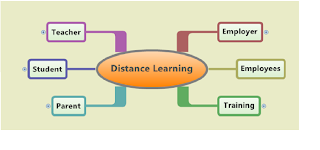This past week has shown me a different outlook of
distance learning. However, I think I still have main concept of distant
leaning in my opinion. My personal definition and observations of distance
learning was all focused online learning. I knew that more institutions are
focusing more on distance learning but I didn’t know it has went to the extreme
that distance learning is also offered to those who are not in college such as
high school students. To me distance learning is only for those who sign up for
the online classes, since online education is not for everyone. Distance
learning to me is for those who choose not to attend a traditional class and
for those who have personal life outside of school and time doesn’t allow them
to conveniently attend class.
Since I have given my explanation of distance
learning, here is what Simonson, et al states about distance learning, “institution-based,
formal education where the learning group is separated, and where interactive
telecommunications systems are used to connect learners, resources, and
instructors,” (p 32, 2012). Instructors and students are separated physically
but through the distance learning, students are required to interact and take quizzes
and test that shows that the student has
received the proper education. “The teaching/learning contract requires that
the student be taught, assessed, given guidance, and where appropriate,
prepared for examinations that may or may be conducted by the institution,”
(Simonson, et al, p 35, 2012).
This week I have learned that many companies are
focusing their training towards online rather than classroom face-to-face. It saves the company money rather than to have
to set up classroom training. I have my negative thoughts about job training
online. To me this gives the employer more time to for their mind to wonder
off. I don’t think it’s a good idea to offer training online for a job.
Also schools are offering online education to
students who have other obligations. When I was in high school online
educational courses was not an option. We only have to attend class or not
attend at all which not attending at all was not an option. Now students have
access to login online and complete assignments when they are not able to
attend class, due to work and traveling. With distance learning, parent also have the option to login to check the status
of their child’s progress in school prior to report cards coming out. When I was
in school, parents didn’t have this option so I do believe that the distance
learning is becoming more popular and convenient to not only the student but to
parents as well.
This week, I have also learned that since teachers
are now being forced to become an online instructor, many do not have the
proper training and are not prepared to teach online. Most teachers are
prepared and trained to teach the traditional way which is face-to-face, but
when forced to teach online they are thrown into the position without the
proper training. “Most of the development work in distance education is being done
by faculty with no formal training in teaching id any kind, not to mention training
in ID or any of the related e-learning fields,” (Moller, L. et al, Part 2,
2008).
As
it all boils down, distance learning is constantly evolving and becoming more
popular. It not only a convenience to college students, but it is becoming more
popular for students that are in high school. Students are now allowed to
complete their assignments online while focusing on jobs, and other
obligations. I think that distance learning is going to change the world and
change many outlooks of online education. Since more institutions are changing their
degree programs to online only, some students may not be happy or may have to
attend another school if they can not focus while attending class online. On the
other hand, I think distance learning is great and very convenient.
Moller, L., Foshay, W., & Huett, J.
(2008). The evolution of distance education: Implications for instructional
design on the potential of the web (Part 2: Higher education). TechTrends,
52(4), 66-70. Retrieved from Academic
Search Complete May 8, 2012.
Simonson, M., Smaldino, S.,
Albright, M., & Zvacek, S. (2012). Teaching and learning at a distance:
Foundations of distance education (5th ed.) Boston, MA: Pearson.

No comments:
Post a Comment